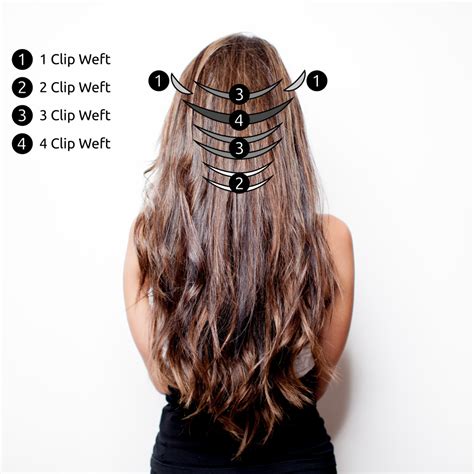Long, luscious hair is a dream come true for many women. But what if nature didn’t bless you with the thick, voluminous locks you crave? Clip-in hair extensions offer a convenient and seamless solution to transform your hairstyle instantly.

In this comprehensive guide, we’ll delve into the realm of clip-in extensions, exploring their benefits, types, and the top 7 must-haves to elevate your hair game.
Why Clip-In Extensions Reign Supreme
- Instant Gratification: Transform your hair in minutes without the commitment of permanent extensions or hair treatments.
- Versatility: Create endless hairstyles, from elegant buns to voluminous ponytails, with ease.
- Damage-Free: Unlike chemical treatments, clip-ins are gentle on your natural hair, causing no breakage or damage.
- Cost-Effective: Clip-ins are significantly more affordable than professional salon extensions or wigs.
The vast array of clip-in extensions available caters to diverse hair types and preferences.
- Human Hair Extensions: Premium quality, most natural-looking option, but also more expensive.
- Synthetic Hair Extensions: Affordable and durable, but less natural in appearance.
- Remy Hair Extensions: Cuticle-aligned human hair, resulting in less tangling and matting.
- Virgin Hair Extensions: Unprocessed human hair, offering the closest match to your natural hair texture.
7 Must-Haves for Good Clip-In Extensions
- High-Quality Hair: Invest in human hair extensions or Remy hair for the most realistic and durable results.
- Secure Clips: Ensure the clips are firmly attached and coated with silicone or rubber for a non-slip grip.
- Matched Color: Choose extensions that perfectly match your natural hair color for an undetectable blend.
- Correct Length: Select extensions with a length that complements your hair length and desired style.
- Natural Weight: Avoid overextending your hair with excessive weight. Opt for extensions that add volume without weighing down your natural hair.
- Comfortable Wear: The clips should be lightweight and comfortable to wear for extended periods.
- Professional Installation: Consider visiting a professional stylist for expert installation, ensuring a flawless finish.
- Lengthen Hair: Add inches of volume and length to your hair instantly.
- Add Volume: Boost thin or fine hair with extensions specifically designed for thickening.
- Create Highlights/Lowlights: Incorporate clip-in extensions in different shades to add depth and dimension to your hair.
- Protect Natural Hair: Clip-ins can shield your natural hair from heat styling and chemical treatments.
Clip-In Extensions Market Trends
According to the global hair extensions market report published by Grand View Research, the market is anticipated to experience a CAGR of 8.9% from 2022 to 2030, reaching approximately USD 15.5 billion by 2030. This growth can be attributed to increasing demand for non-invasive hair enhancements and the growing influence of social media.
Clip-in extensions have transcended their traditional use, inspiring innovative applications in various industries.
- Cosmetology Education: Provide students with hands-on experience in hair extension techniques.
- Entertainment: Enhance character transformations for film, television, and stage productions.
- Fashion Photography: Create captivating hairstyles for editorial shoots and fashion shows.
- Cosplay: Bring iconic anime and video game characters to life with vividly colored extensions.
Table 1: Types of Clip-In Extensions
| Extension Type | Advantages | Disadvantages |
|---|---|---|
| Human Hair | Most natural-looking, durable | Expensive |
| Synthetic Hair | Affordable, durable | Less natural-looking |
| Remy Hair | Cuticle-aligned, less tangling | Can be more expensive than synthetic hair |
| Virgin Hair | Unprocessed, closest match to natural hair texture | Most expensive |
Table 2: Benefits of Clip-In Extensions
| Benefit | Use Case |
|---|---|
| Lengthen Hair | Add inches of volume and length |
| Add Volume | Boost thin or fine hair |
| Create Highlights/Lowlights | Add depth and dimension to hair |
| Protect Natural Hair | Shield hair from heat styling and chemical treatments |
Table 3: Applications of Clip-In Extensions
| Application | Industry |
|---|---|
| Cosmetology Education | Hair Extension Training |
| Entertainment | Film, Television, Stage |
| Fashion Photography | Editorial Shoots |
| Cosplay | Character Transformations |
Table 4: Step-by-Step Guide to Installing Clip-In Extensions
| Step | Instruction |
|---|---|
| 1 | Section your hair and separate the top layer. |
| 2 | Position the extension near the roots of the bottom layer. |
| 3 | Close the clip securely by pressing firmly. |
| 4 | Repeat steps 2-3 for all extensions. |
| 5 | Release and blend the top layer of hair over the extensions. |
FAQs
1. How long can I wear clip-in extensions?
Clip-ins can be worn for 6-8 hours comfortably. However, excessive wear can damage your natural hair.
2. Can I sleep in clip-in extensions?
It’s highly recommended to remove clip-ins before sleeping to prevent tangling and damage.
3. How often should I wash my clip-in extensions?
Wash human hair extensions every 10-15 wears or as needed. Synthetic extensions can be washed more frequently.
4. How do I blend clip-in extensions with my natural hair?
Use a curling iron or flat iron to blend the textures of your natural hair and the extensions.
5. Can I dye clip-in extensions?
Only human hair extensions can be colored. Consult a professional stylist for safe and effective coloring.
6. How do I store clip-in extensions when not in use?
Store extensions in a cool, dry place, free from dust and moisture. Use a storage bag or box to protect them from tangling.
7. Should I use hairspray on my clip-in extensions?
Use hairspray sparingly to avoid buildup. Focus on spraying the natural hair around the extensions to blend them seamlessly.
8. How often should I replace my clip-in extensions?
With proper care, human hair extensions can last up to a year, while synthetic extensions typically need to be replaced every 6-9 months.
